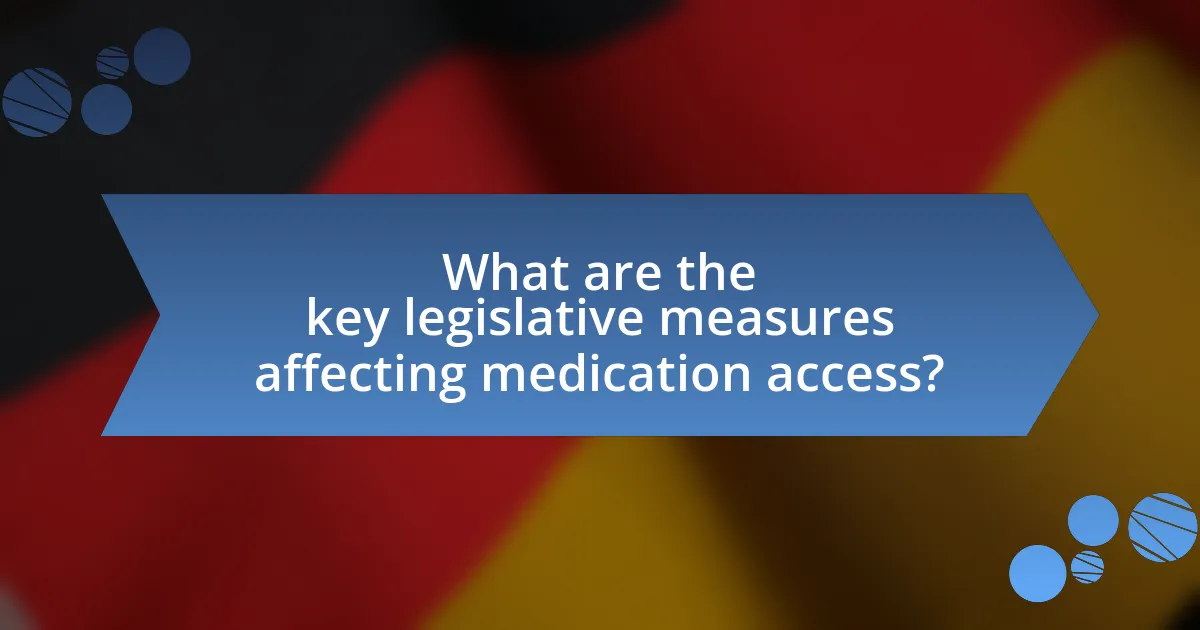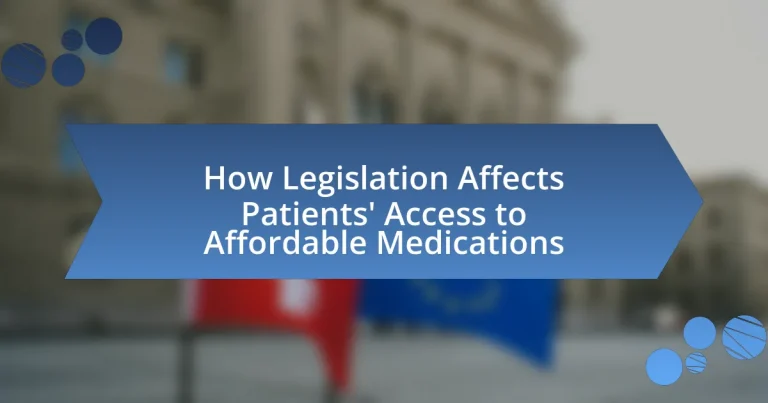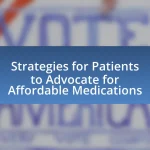Legislation plays a crucial role in shaping patients’ access to affordable medications by regulating drug pricing, patent laws, and insurance coverage. Key legislative measures, such as the Affordable Care Act and the Drug Price Competition and Patent Term Restoration Act, have expanded insurance coverage and facilitated the entry of generic drugs, significantly lowering medication costs. The article examines various types of legislation impacting medication pricing, the effects of price control and patent laws, and the importance of government programs like Medicaid and Medicare in enhancing access to essential treatments. Additionally, it discusses recent legislative changes aimed at reducing drug prices and provides strategies for patients to navigate the legislative landscape for better access to affordable medications.
How does legislation influence patients’ access to affordable medications?
Legislation significantly influences patients’ access to affordable medications by establishing regulations that control drug pricing, patent laws, and insurance coverage. For instance, laws such as the Affordable Care Act have expanded insurance coverage, thereby increasing access to necessary medications for millions of Americans. Additionally, legislation like the Drug Price Competition and Patent Term Restoration Act facilitates the entry of generic drugs into the market, which lowers prices and enhances affordability. According to a 2021 report from the House of Representatives, the introduction of generics can reduce drug costs by up to 80%, demonstrating the direct impact of legislative measures on medication affordability.
What types of legislation impact medication pricing?
Various types of legislation impact medication pricing, including price control laws, patent laws, and healthcare reform acts. Price control laws, such as those implemented in some countries, directly limit the prices that pharmaceutical companies can charge for medications. Patent laws influence medication pricing by granting exclusive rights to manufacturers, which can lead to higher prices due to lack of competition. Healthcare reform acts, like the Affordable Care Act in the United States, can affect pricing by altering how medications are covered and reimbursed, thereby influencing overall costs for consumers. These legislative frameworks collectively shape the landscape of medication pricing and access for patients.
How do price control laws affect medication affordability?
Price control laws generally increase medication affordability by limiting the prices that pharmaceutical companies can charge for their products. These laws aim to make essential medications accessible to a broader population, particularly in regions where high drug prices can lead to significant financial burdens. For instance, countries with established price control mechanisms, such as Canada, often report lower average prices for prescription drugs compared to the United States, where such regulations are less common. A study published in the Journal of Health Economics found that price controls can lead to a reduction in out-of-pocket expenses for patients, thereby improving access to necessary treatments.
What role do patent laws play in medication access?
Patent laws significantly influence medication access by granting exclusive rights to pharmaceutical companies for a specified period, typically 20 years. This exclusivity allows companies to recoup research and development costs, but it can also lead to high drug prices, limiting access for patients. For instance, the World Health Organization has reported that patented medications can be up to 10 times more expensive than generics, which are often not available until patents expire. Consequently, while patent laws incentivize innovation, they can create barriers to affordable medication access for patients, particularly in low-income regions.
Why is legislation important for patient access to medications?
Legislation is crucial for patient access to medications because it establishes the regulatory framework that governs drug approval, pricing, and distribution. This framework ensures that medications are safe, effective, and available to patients in a timely manner. For instance, the Food and Drug Administration (FDA) in the United States plays a vital role in evaluating new drugs before they reach the market, which directly impacts patient access by ensuring that only safe and effective medications are prescribed. Additionally, legislation can influence pricing structures through policies that promote competition among pharmaceutical companies, thereby making medications more affordable. For example, the Affordable Care Act introduced provisions that expanded access to prescription drugs for millions of Americans, demonstrating how legislative measures can enhance patient access to necessary medications.
How does legislation shape the pharmaceutical market?
Legislation shapes the pharmaceutical market by establishing regulatory frameworks that govern drug approval, pricing, and market access. For instance, the Food and Drug Administration (FDA) in the United States sets stringent guidelines for the safety and efficacy of medications before they can be marketed, which directly influences the types of drugs available to consumers. Additionally, laws such as the Drug Price Competition and Patent Term Restoration Act of 1984 facilitate the entry of generic drugs, thereby increasing competition and potentially lowering prices. Furthermore, legislation can impact patient access to medications through policies like the Affordable Care Act, which expanded insurance coverage and mandated that certain essential medications be included in health plans. These legislative measures collectively determine the dynamics of supply, pricing, and accessibility within the pharmaceutical market.
What are the consequences of inadequate legislation on patient health?
Inadequate legislation on patient health leads to increased medication costs, reduced access to essential treatments, and compromised patient safety. For instance, when laws do not regulate drug pricing effectively, patients may face exorbitant costs, resulting in non-adherence to prescribed therapies. A study published in the Journal of the American Medical Association found that nearly 25% of patients reported not filling prescriptions due to high costs, which can exacerbate health conditions and lead to higher long-term healthcare expenses. Furthermore, insufficient regulation can allow for the proliferation of substandard medications, posing significant risks to patient safety and overall health outcomes.

What are the key legislative measures affecting medication access?
Key legislative measures affecting medication access include the Affordable Care Act (ACA), the Drug Price Competition and Patent Term Restoration Act, and the 21st Century Cures Act. The ACA expanded Medicaid and provided subsidies for purchasing insurance, increasing access to medications for millions. The Drug Price Competition and Patent Term Restoration Act facilitated the entry of generic drugs into the market, lowering prices and improving access. The 21st Century Cures Act aimed to streamline the drug approval process, enhancing the availability of new treatments. These measures collectively aim to improve affordability and accessibility of medications for patients.
How do government programs influence medication affordability?
Government programs influence medication affordability by providing financial assistance, regulating prices, and facilitating access to essential drugs. For instance, programs like Medicaid and Medicare in the United States help low-income individuals and seniors afford medications by covering a significant portion of drug costs. According to the Kaiser Family Foundation, Medicaid expansion has led to increased access to prescription drugs for millions of low-income individuals, thereby reducing out-of-pocket expenses. Additionally, government negotiations with pharmaceutical companies can lead to lower prices for medications, as seen in countries with national health systems that set price controls. These mechanisms collectively enhance medication affordability and improve public health outcomes.
What is the impact of Medicaid and Medicare on access to medications?
Medicaid and Medicare significantly enhance access to medications for millions of Americans. Medicaid provides coverage for low-income individuals, ensuring they can afford necessary prescriptions, while Medicare offers similar support to seniors and certain disabled individuals. According to the Kaiser Family Foundation, nearly 70 million people are enrolled in Medicaid, and over 60 million are covered by Medicare, which collectively facilitates access to essential medications through various formularies and cost-sharing structures. These programs help reduce out-of-pocket costs, making medications more affordable and accessible, thereby improving health outcomes for vulnerable populations.
How do drug discount programs work for patients?
Drug discount programs provide patients with reduced prices on medications, making them more affordable. These programs typically operate through partnerships between pharmaceutical companies, pharmacies, and sometimes non-profit organizations, which offer discounts or coupons that patients can use at the point of sale. For instance, a patient may present a discount card at a pharmacy, which applies a predetermined reduction to the medication’s retail price, thereby lowering the out-of-pocket cost. According to a study published in the Journal of Managed Care & Specialty Pharmacy, patients using discount programs can save an average of 30% on their prescriptions, demonstrating the financial impact these programs can have on medication affordability.
What recent legislative changes have affected medication access?
Recent legislative changes that have affected medication access include the Inflation Reduction Act of 2022, which allows Medicare to negotiate prices for certain high-cost drugs, thereby potentially lowering out-of-pocket expenses for beneficiaries. Additionally, the Affordable Care Act has been expanded to include provisions that cap insulin costs for patients at $35 per month, improving affordability for those with diabetes. These changes aim to enhance access to essential medications for millions of Americans, particularly those with chronic conditions.
How have recent laws aimed at reducing drug prices been implemented?
Recent laws aimed at reducing drug prices have been implemented through mechanisms such as price negotiation, transparency requirements, and caps on out-of-pocket costs. For instance, the Inflation Reduction Act allows Medicare to negotiate prices for certain high-cost drugs, which is expected to lower expenses for beneficiaries. Additionally, laws have mandated that pharmaceutical companies disclose pricing information, enhancing market transparency and enabling consumers to make informed choices. These legislative measures are designed to directly impact the affordability of medications for patients, as evidenced by projected savings of billions in drug costs over the coming years.
What are the implications of these changes for patients?
The implications of these changes for patients include improved access to affordable medications, which can lead to better health outcomes. Legislation aimed at reducing drug prices often results in lower out-of-pocket costs for patients, making essential medications more accessible. For instance, the introduction of price negotiation policies has been shown to decrease the financial burden on patients, as evidenced by studies indicating that countries with such regulations experience lower medication costs compared to those without. This increased affordability can enhance medication adherence, ultimately improving overall patient health and reducing hospitalizations related to untreated conditions.

How can patients navigate the legislative landscape for better access?
Patients can navigate the legislative landscape for better access by actively engaging in advocacy efforts and staying informed about relevant policies. Engaging with local and national advocacy groups, such as the American Cancer Society or the National Patient Advocate Foundation, provides patients with resources and support to influence legislation. Additionally, patients should regularly monitor legislative updates through government websites and trusted news sources to understand changes that may affect their access to medications. Research indicates that informed patients who participate in advocacy can significantly impact policy decisions, as seen in the 2021 passage of the Affordable Insulin Act, which aimed to reduce insulin costs for patients.
What resources are available for patients seeking affordable medications?
Patients seeking affordable medications can access various resources, including patient assistance programs, discount cards, and online platforms that compare drug prices. Patient assistance programs, often provided by pharmaceutical companies, offer free or low-cost medications to eligible individuals based on income and insurance status. Discount cards, such as those from GoodRx or SingleCare, can significantly reduce out-of-pocket costs by providing lower prices at participating pharmacies. Additionally, websites like RxSaver and Blink Health allow patients to compare prices for medications across different pharmacies, ensuring they find the most affordable options. These resources are essential for improving access to necessary medications, especially in light of rising drug costs and legislative changes affecting healthcare affordability.
How can patients advocate for better legislation?
Patients can advocate for better legislation by actively engaging with lawmakers, participating in advocacy groups, and sharing personal stories that highlight the impact of current policies on their access to medications. Engaging with lawmakers can involve writing letters, making phone calls, or attending town hall meetings to express concerns and suggest changes. Advocacy groups, such as the National Patient Advocate Foundation, provide resources and platforms for collective action, amplifying patient voices. Sharing personal experiences can effectively illustrate the real-world consequences of legislation, making it more relatable and urgent for policymakers. Studies show that personal narratives can significantly influence legislative outcomes, as they humanize the issues at stake and foster empathy among decision-makers.
What strategies can patients use to access medications under current laws?
Patients can access medications under current laws by utilizing prescription assistance programs, negotiating prices, and exploring generic alternatives. Prescription assistance programs, often provided by pharmaceutical companies or non-profit organizations, help patients afford medications by offering discounts or free medications based on income and eligibility criteria. Negotiating prices with pharmacists or using discount cards can also lower out-of-pocket costs, as many pharmacies offer price matching or discounts for cash payments. Additionally, patients can opt for generic medications, which are typically more affordable than brand-name drugs, while still being therapeutically equivalent. According to the FDA, generic drugs can save patients up to 80% compared to their brand-name counterparts, making them a viable option for accessing necessary medications affordably.
What best practices should patients follow to ensure access to affordable medications?
Patients should compare prices across different pharmacies to ensure access to affordable medications. Research indicates that medication prices can vary significantly, with a study showing that consumers can save up to 80% by shopping around. Additionally, patients should utilize prescription discount programs and patient assistance programs offered by pharmaceutical companies, which can provide medications at reduced costs or even for free. Engaging with healthcare providers to discuss generic alternatives is also crucial, as generics can be significantly cheaper than brand-name drugs. Furthermore, patients should stay informed about their insurance coverage and any changes in legislation that may affect medication costs, as policies can impact out-of-pocket expenses.


